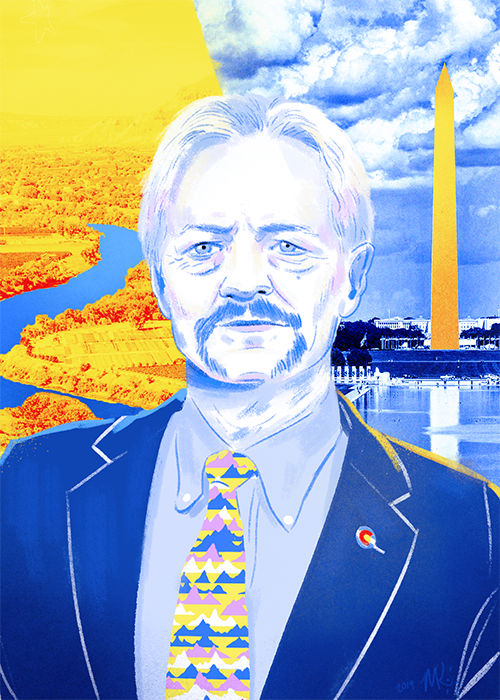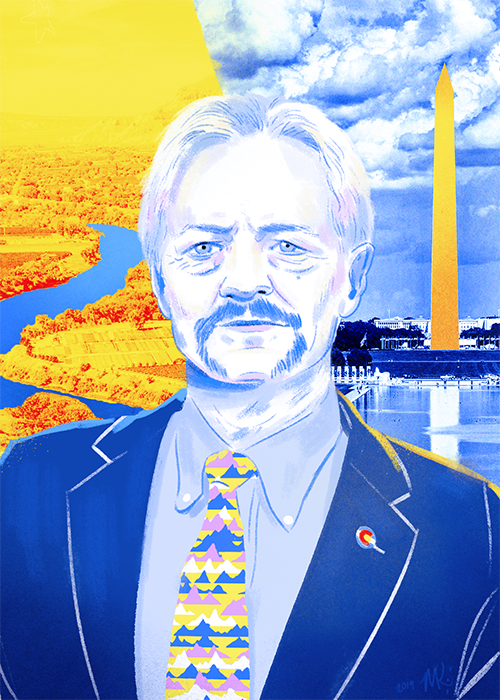
William Perry Pendley left much to speculation during his first appearance before Congress as the Bureau of Land Management’s acting director, not least of which his opinion on remote workforce technology. Pendley appeared before the House Natural Resources Committee Tuesday to justify his bureau’s decision to relocate some 320 Washington, D.C.-based employees to offices in the West, including a new BLM headquarters in Grand Junction, Colorado. How, lawmakers wondered, would staffers be able to effectively communicate with decision-makers at the Capitol?
“We’re in a new technological world,” Pendley said, implying that BLM staffers who craft and implement policy don’t need to be in D.C., where legislators and all the other agencies are. Pick up the phone; Skype if you have to. Problem solved.
But smartphones apparently don’t work the other way around. Again, Pendley: “We at the Department of Interior are making decisions based on papers, photographs, and maps, when we really need our experts, our top people in Washington, on the site.”
Photographs and maps — such antiquated technology, by Pendley’s reasoning, should be substituted for D.C. staffers moving West and “seeing sagebrush for the first time.” Never mind that 9,000-plus BLM staffers — at least 93 percent of the agency’s workforce — are already based out West and likely see sagebrush every day. BLM manages nearly 250 million acres, doing everything from environmental monitoring to wild horse round-ups to processing oil-and-gas permits. State and field office directors do all the things Pendley said his D.C. people could improve upon: working with governors, consulting with tribes, meeting with local stakeholders. So, instead of convincing lawmakers that BLM’s headquarters move was a good idea, Pendley instead presented a scenario experts say will hinder BLM’s governmental operations and do little, if anything, to improve on-the-ground relationships between the agency and the Western communities it serves.
Under the plan advanced by Interior Secretary David Bernhardt in July, just 61 BLM staffers would remain in D.C. Another 300 or so — including the BLM director, if one is ever nominated — would be relocated to offices in seven Western states, including 27 to the new Grand Junction headquarters. Pendley said relocation announcements could come next week. According to documents obtained by The Hill, some policy analysts and legislative affairs workers would be relocated to Reno, Nevada, and an international affairs specialist would be moved to Salt Lake City.
Steve Ellis, a former deputy director for operations at BLM (a career position, not a political appointment) told the website the move makes little sense. “Why,” he said, “would you put your legislative affairs staff in Reno, Nevada, when Congress — who they work with — is in Washington, D.C.?”
Lawmakers on Tuesday were similarly perplexed, and Pendley only muddied the waters. Representative Diana DeGette, whose district includes much of metro Denver, asked Pendley if he wouldn’t be better served to focus on fully staffing state offices instead of relocating headquarters; Pendley said those two things shouldn’t be conflated. Eight minutes later, he performed said conflation. Representative Paul Tonko of New York asked how scattering headquarters employees across 12 offices would improve efficiency, to which Pendley responded: “What we hear consistently from members of Congress, governors, Western leaders, stakeholders, our partners in the field, is simply that we don’t have the staffing we need in the field offices and the state offices to be responsive.”
Ever since then-Interior Secretary Ryan Zinke first proposed reorganizing the entire Interior Department in January 2018 (the current BLM shuffling is a downsized version of that plan; Interior has 70,000 employees), career staffers have cautioned that doing so would water down agency influence in the Capitol.
“This plan is so radical,” said Edward Shepard, president of the Public Lands Foundation, a nonpartisan group of former BLM workers, “that we really questioned if it was studied by non-political budget analysts or organizational experts, and whether career BLM senior management was involved or consulted. … We fully believe this reorganization would functionally dismantle the BLM.”
Indeed, many have said this is a veiled attempt to wither an agency overseeing land that a fringe group of Westerners — among them Senator Mike Lee of Utah and a former property-rights attorney named William Perry Pendley — believe shouldn’t be under federal control in the first place. The thinking is as follows: After seizing land from American Indian tribes, the U.S. tried to get rid of all of it through the various Homestead acts; what wasn’t snapped up should’ve been transferred to the states. Or, as Pendley himself wrote in a 2016 National Review op-ed: “The Founding Fathers intended all lands owned by the federal government to be sold. After all, jurisdiction over real property, that is, property law, was given to the states.” The vast majority of constitutional and land-use lawyers, it should be noted, cite myriad court cases and the Constitution’s Property Clause that say public lands are OK.
What settlers didn’t claim back in the 19th century was the arid scrubland that couldn’t support small farms and ranches; today, it’s managed mostly by the BLM to balance multiple uses — grazing, recreation, energy development, and the like. Pendley and others in the Sagebrush Rebellion camp (Pendley’s Twitter handle until recently was @Sagebrush_Rebel), who since the 1970s have argued BLM should cede land and/or authority to states, are now in positions of power, and BLM watchers and former employees are concerned about motives.
Trump administration officials, including former Secretary Zinke and current chief of staff Mick Mulvaney, have publicly stated they view reassignments as a method to thin out staff. It’s been reported that many positions being offered to headquarters staff out West are of lower qualifications and pay. In a notice to Senator Lisa Murkowski, who chairs the subcommittee that handles Interior appropriations, Bernhardt made note that BLM would save $50 million a year on cost-of-living adjustments to employee salaries. (Pendley repeatedly said Tuesday that BLM staffers who didn’t want to relocate would be given jobs elsewhere in Interior.)
A clear rationale for a BLM headquarters move didn’t emerge on Tuesday. Questioning from committee chair Raúl Grijalva of Arizona revealed no analysis has been done on the projected number of staff defections, how the move might affect staff diversity, nor how the agency plans to retain longtime employees — none of whom yet know whether their positions will be moving west. Congress has yet to fund the relocation effort beyond a $5.6 million allocation. The House passed legislation in May to block the relocation; a Democratic president or Senate in 2020 could put the kibosh on the whole thing.
Furthermore, there’s already a system in place for the localized, on-the-ground decision-making Pendley and other Interior leaders are calling for. State BLM directors work closely with governors, and have historically had wide berths when it comes to implementing management plans.
During the hearing, Representative Paul Gosar of Arizona bemoaned that “the swamp wants to keep centralized control of everything,” and said dispersing BLM workers west would restore power to Western communities. But Interior has done the opposite in recent years. Beginning when Zinke was in office, the department began shifting decision-making control away from state directors and to Washington. BLM’s recent flurry of oil-and-gas leases, for instance, have come despite some agreements struck at the state level to hold off on new drilling.
That’s one reason Shepard’s 600-member Public Lands Foundation opposes the headquarters relocation. “If the goal of the plan is to return decision making to the local level,” he told the House committee, “then we suggest the department return the decision-making authority to local BLM managers who work daily with folks in the community.”

